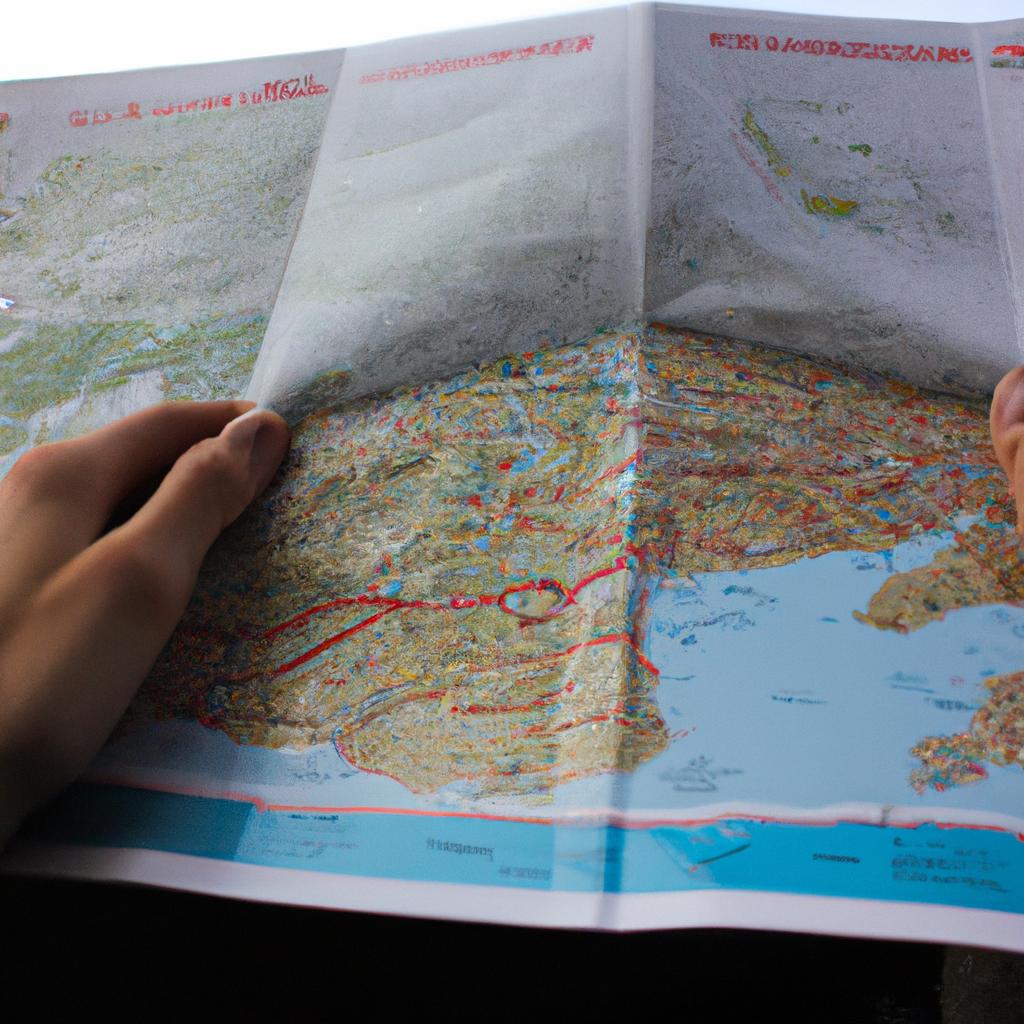Traveling in North America can be an exciting and enriching experience, allowing individuals to explore diverse landscapes, cultures, and cuisines. However, managing finances while traveling in this vast continent can present various challenges that require careful planning and decision-making. For instance, consider the case of Sarah, a budget-conscious traveler from Europe who embarked on a three-month journey across North America. As she traversed through different countries and cities, Sarah encountered unique financial considerations such as fluctuating exchange rates, varying costs of accommodation and transportation, as well as unexpected expenses.
Effectively managing finances is crucial for travelers like Sarah to ensure they make the most out of their experiences while staying within their allocated budgets. This article aims to provide practical insights and strategies for navigating the financial aspects of traveling in North America. In particular, it will delve into topics such as understanding currency exchange dynamics, identifying cost-effective accommodation options, optimizing transportation choices, and preparing for unforeseen expenses. By equipping readers with these essential tools and knowledge, this article seeks to empower travelers with the ability to make informed financial decisions throughout their journeys in North America.
Choosing the Right Travel Destinations in North America
Choosing the Right Travel Destinations in North America
When planning a trip to North America, one of the first and most crucial decisions is choosing the right travel destinations. By selecting locations that align with your interests and preferences, you can ensure a fulfilling and memorable experience. For instance, imagine a traveler who loves outdoor adventures such as hiking and camping. They may consider visiting Banff National Park in Canada or Yosemite National Park in the United States, both renowned for their breathtaking landscapes and extensive trail networks.
To assist you further in making an informed decision about where to go in North America, here are some factors to consider:
-
Interests: Identify what type of activities or attractions appeal to you. Are you interested in exploring vibrant cities, immersing yourself in cultural experiences, or indulging in natural wonders? Understanding your interests will help narrow down potential destinations that offer those specific features.
-
Budget: Evaluate your financial resources and determine how much you are willing to spend on your trip. Keep in mind that prices vary across different regions within North America. Consider the cost of accommodation, transportation, meals, entrance fees to attractions, and any other expenses associated with your desired destinations.
-
Seasonality: Be mindful of seasonal variations when choosing your travel destinations. Some places might be more enjoyable during certain times of the year due to weather conditions or special events happening at that time. Researching climate patterns and peak tourist seasons can help you make an informed decision.
-
Accessibility: Assess how easily accessible your chosen destinations are from major transportation hubs like airports or train stations. Consider whether there are direct flights available or if additional connections would be required to reach your desired location efficiently.
Here’s an example table showcasing four popular travel destinations in North America along with their standout features:
| Destination | Main Attractions | Best Time to Visit |
|---|---|---|
| New York City | Iconic landmarks (Statue of Liberty, Times Square) | Spring and Fall |
| Vancouver | Scenic beauty (Stanley Park, Capilano Suspension Bridge) | Summer |
| Cancun | Pristine beaches, crystal-clear waters | Winter/Spring |
| San Francisco | Golden Gate Bridge, Alcatraz Island | Year-round |
By considering these factors and examining the table above, you can evaluate various travel destinations in North America objectively. Once you have chosen your ideal location or locations, it’s time to move on to creating a realistic travel budget for your trip.
Transitioning into the subsequent section about “Creating a Realistic Travel Budget for Your Trip,” understanding the financial aspects is crucial when planning your journey. By now, you have determined where you want to go; next comes the practical aspect of determining how much you need to save and spend during your travels.
Creating a Realistic Travel Budget for Your Trip
Choosing the Right Travel Destinations in North America is just the first step towards planning an unforgettable trip. Once you have decided on your destinations, it’s time to start thinking about creating a realistic travel budget. Let’s explore some essential factors to consider when managing your finances for traveling in North America.
To illustrate these factors, let’s take the example of Sarah, who is planning a 3-week road trip across Canada and the United States. She has already chosen her destinations, including Vancouver, Banff National Park, San Francisco, New York City, and Miami. Now, she needs to allocate her funds wisely to make the most out of her journey.
Firstly, transportation costs should be one of the main considerations when setting up a travel budget. Depending on your preferences and itinerary, you may need to include expenses such as flights or train tickets between cities or countries. In Sarah’s case, she will need to factor in fuel costs for her car rental throughout her road trip and any tolls that may apply along the way.
Secondly, accommodation expenses play a significant role in determining your overall travel budget. Consider options like hotels, hostels, vacation rentals (such as Airbnb), or even camping if you’re adventurous. To help you visualize this aspect further, here are four key points regarding accommodation costs:
- Accommodation prices can vary significantly depending on location and season.
- Staying outside city centers can often be more affordable.
- Researching deals and promotions in advance can save you money.
- Sharing accommodations with friends or family can help split costs effectively.
Now let’s take a look at a table comparing average daily accommodation costs for different types of lodging across popular North American cities:
| City | Hotel | Hostel | Vacation Rental |
|---|---|---|---|
| Vancouver | $150-$250 | $30-$50 | $100-$150 |
| Banff National Park | $200-$350 | $25-$40 | $120-$170 |
| San Francisco | $180-$300 | $35-$60 | $110-$160 |
| New York City | $250-$400 | $30-$70 | $130-$200 |
| Miami | $200-$350 | $20-$45 | $100-$140 |
Lastly, don’t forget to account for daily expenses such as meals, activities, and any unexpected costs that may arise during your trip. It’s helpful to create a separate category in your budget for these miscellaneous expenses. By estimating the approximate amount you’ll need per day and setting aside some additional funds for emergencies or unforeseen circumstances, you can ensure a smoother financial management throughout your journey.
As we move forward into the next section about Saving Money on Accommodation in North America, keep in mind that being strategic with your finances will not only allow you to stay within your travel budget but also enable you to experience more of what North America has to offer without breaking the bank.
Saving Money on Accommodation in North America
Saving Money on Accommodation in North America
In order to effectively manage your finances while traveling in North America, it is essential to find ways to save money on accommodation. One example of how you can achieve this is by considering alternative options such as staying in hostels or booking through vacation rental platforms like Airbnb.
Hostels are a popular choice among budget travelers and backpackers due to their affordability and social atmosphere. By opting for a shared dormitory instead of a private room, you can significantly reduce the cost of accommodation. Additionally, many hostels offer communal kitchens where you can prepare your own meals, saving even more money on dining expenses.
Another option worth exploring is utilizing vacation rental platforms like Airbnb. These platforms allow individuals to rent out their homes or spare rooms at affordable rates. Not only does this provide an opportunity to experience local living arrangements, but it also often offers more space and amenities compared to traditional hotels.
To further assist you in finding suitable accommodation that fits within your budget, here are some tips:
- Be flexible with dates: Consider traveling during off-peak seasons or weekdays when prices tend to be lower.
- Research different neighborhoods: Some areas may have cheaper options available while still providing convenient access to tourist attractions.
- Read reviews: Take time to read reviews from previous guests before making any reservations to ensure the place meets your expectations.
- Negotiate prices: In certain situations, especially if you plan on staying for an extended period, negotiating with hosts or hotel staff might lead to additional discounts.
By implementing these strategies and being mindful of your spending on accommodations, you can optimize your travel budget and allocate funds towards other aspects of your journey.
Note: The following table highlights average nightly costs across various types of accommodations in popular North American cities.
| City | Hotel | Hostel | Vacation Rental |
|---|---|---|---|
| New York | $200 | $35 | $150 |
| Los Angeles | $180 | $30 | $120 |
| Toronto | $160 | $25 | $100 |
| Vancouver | $170 | $28 | $130 |
Source: Average prices based on data from reputable travel websites.
Optimizing Transportation Costs while Traveling
Optimizing Transportation Costs while Traveling
Imagine you are planning a trip across North America, aiming to explore the diverse landscapes and vibrant cities. As you plan your itinerary, it is essential to consider how to optimize transportation costs. One way to achieve this is by making strategic choices that allow for both convenience and affordability.
For instance, let’s consider the case of Sarah, an avid traveler who embarked on a three-month journey across North America. To keep her expenses in check without compromising her travel experience, she implemented several cost-saving measures when it came to transportation.
Here are some strategies you can employ to optimize transportation costs during your travels:
- Research and compare: Before booking any mode of transportation, conduct thorough research and compare prices from different providers or platforms.
- Flexible dates and times: Being flexible with your travel dates and times can often lead to significant savings. Consider traveling during off-peak seasons or weekdays when fares tend to be lower.
- Public transportation: Utilize public transportation options like buses or trains whenever possible. These modes of transport are usually more affordable than renting a car or taking flights between nearby destinations.
- Ridesharing services: Explore ridesharing services such as Uber or Lyft, which may offer cost-effective alternatives compared to traditional taxis.
To illustrate the potential savings through careful planning, let’s take a look at the following table:
| Mode of Transportation | Cost (USD) |
|---|---|
| Flight | $300 |
| Train | $150 |
| Bus | $100 |
| Rideshare | $75 |
By opting for a bus ride instead of a flight for shorter distances within North America, travelers like Sarah can save up to $200 per journey. Such savings over multiple trips can significantly reduce overall transportation expenses while still allowing ample exploration opportunities.
As you plan your trip across North America, optimizing your transportation costs can contribute to a more budget-friendly adventure. By employing strategies like researching, being flexible with dates and times, utilizing public transportation, and considering ridesharing services, you can achieve significant savings without compromising on the quality of your travel experience.
Transitioning into the subsequent section about “Managing Food and Dining Expenses on Your Trip,” it is crucial to explore ways to ensure affordable yet enjoyable dining experiences throughout your journey.
Managing Food and Dining Expenses on Your Trip
When planning a trip to North America, optimizing transportation costs is crucial for managing your finances effectively. By making smart choices and utilizing various strategies, you can minimize expenses and maximize the value of your travel experience.
For instance, let’s consider the case of Sarah who planned a road trip across Canada. Instead of renting a car for the entire duration of her journey, she decided to rent one only when needed. This approach allowed her to save money on rental fees, parking charges, and maintenance costs. Additionally, Sarah researched different car rental companies in advance and compared prices to find the most affordable option without compromising on quality.
To further assist you in optimizing transportation costs during your trip, here are some valuable tips:
- Consider using public transportation: Utilize local buses or trains whenever possible as they are often more cost-effective than taxis or ride-sharing services.
- Explore alternative options: Look into bike rentals or walking tours for short distances within cities. Not only will this help reduce transportation costs but also provide an opportunity to explore the area at a leisurely pace.
- Plan flights strategically: When flying between destinations, try booking non-stop flights instead of connecting ones as they tend to be less expensive and more time-efficient.
- Leverage loyalty programs: If you frequently travel within North America, consider signing up for airline loyalty programs that offer discounts, free baggage allowances, and other perks.
In addition to these suggestions, it is useful to understand how various factors affect transportation costs in North America. The table below provides an overview of average prices (in USD) for common modes of transportation:
| Mode of Transportation | Average Cost |
|---|---|
| Domestic Flight | $300 |
| Intercity Bus | $50 |
| Train | $100 |
| Rental Car | $40/day |
As you plan your trip through North America with a focus on optimizing transportation costs, keep these recommendations and price ranges in mind to make informed decisions that align with your budget.
To further manage your finances while traveling, it is essential to control miscellaneous expenses. By being mindful of your spending habits, you can save money without sacrificing the quality of your overall experience.
Tips for Controlling Miscellaneous Expenses during Travel
Managing Finances: Traveling in North America
Section H2: Managing Food and Dining Expenses on Your Trip
In the previous section, we discussed effective strategies for managing food and dining expenses during your trip. Now, let’s turn our attention to controlling miscellaneous expenses that can quickly add up and impact your overall budget.
Consider this hypothetical scenario: You’re traveling through North America and come across a charming local market offering unique handmade crafts. The temptation to buy souvenirs is hard to resist, but it’s essential to be mindful of these extra expenses. By implementing the following tips, you can ensure better control over your overall expenditure:
- Set a realistic budget: Before embarking on your journey, determine how much money you are willing to allocate towards miscellaneous expenses such as shopping or entertainment. This will help guide your spending decisions and prevent overspending.
- Prioritize experiences over material possessions: Instead of buying numerous trinkets that may end up forgotten at home, consider investing in activities or excursions that create lasting memories. Focus on immersing yourself in the local culture and exploring attractions specific to each destination.
- Research free or low-cost activities: Many cities offer an array of cost-effective or even free options for visitors. From public parks and museums with discounted admission fees to walking tours led by knowledgeable locals, these alternatives provide opportunities for exploration without breaking the bank.
- Practice self-discipline: While it’s important to enjoy yourself during your travels, exercise self-control when faced with impulse purchases. Take some time before making any non-essential purchases, allowing yourself space to evaluate whether they align with your priorities and budget.
To further illustrate the impact of controlling miscellaneous expenses while traveling in North America, let’s look at a comparison table showcasing two different approaches:
| Uncontrolled Spending | Controlled Spending | |
|---|---|---|
| Shopping | Frequent purchases | Selective and mindful |
| Entertainment | Expensive attractions | Budget-friendly options |
| Souvenirs | Excessive shopping | Limited to essentials |
| Miscellaneous Expenses Total | $500 | $200 |
By consciously managing your expenses and adhering to a well-planned budget, you can maximize your travel experiences without compromising your financial stability. Remember, the key lies in striking a balance between indulging yourself while also being prudent in your spending choices.
In summary, by setting a realistic budget, prioritizing experiences over material possessions, researching cost-effective activities, and practicing self-discipline when it comes to impulse buying, you can effectively control miscellaneous expenses during your travels. With these strategies in place, you will be able to make the most of your trip through North America while maintaining financial responsibility.
 Island Gourmet Safaris
Island Gourmet Safaris



